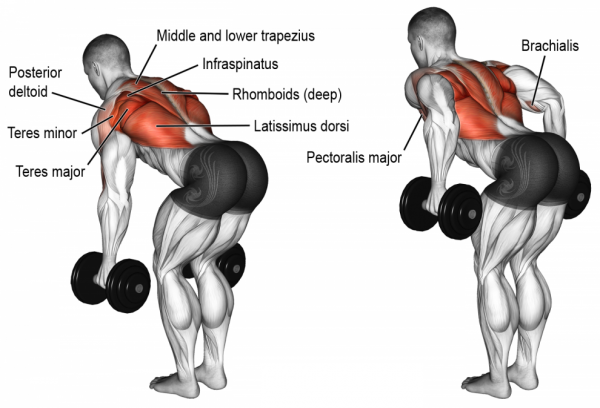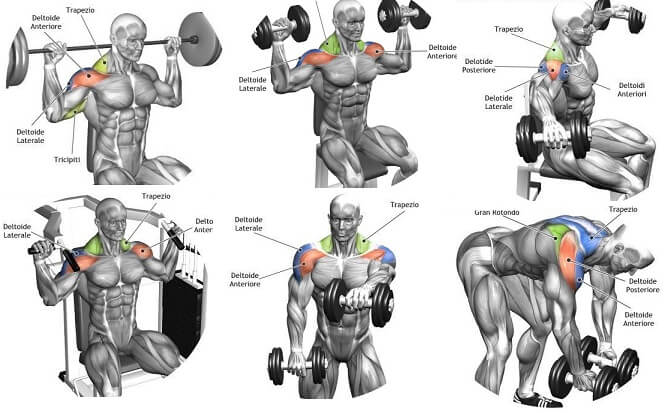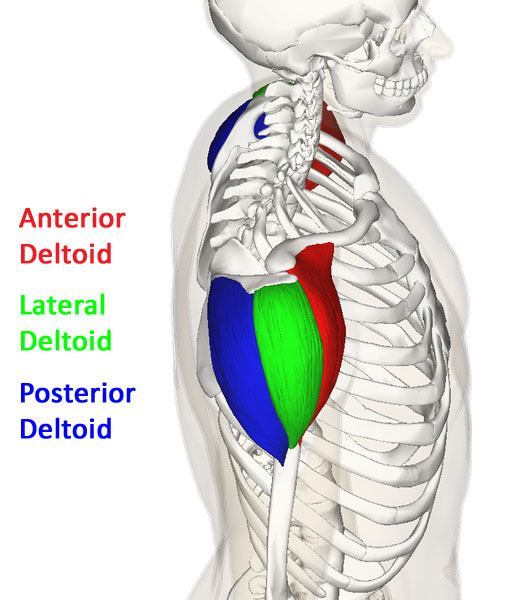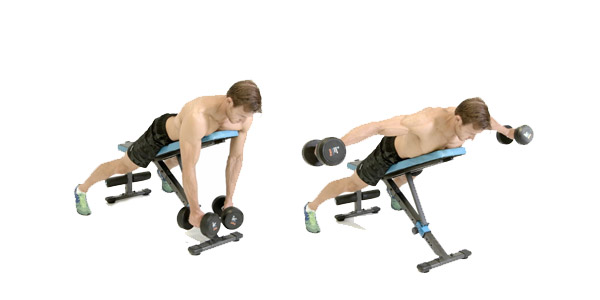The key to developing delts that have a round, three-dimensional look is to proportionally develop all three heads. That way your delts look full whether viewed from the front, rear, or side.
The most common mal-development pattern among trainers is having well developed front delts, moderately developed middle delts and seriously lagging rear delts.
This will typically manifest itself by significant internal rotation of the shoulder. Showing if your palms face more to the rear as opposed to your side when you’re standing relaxed.
This probably has to do with:
- Love for the bench press and chest training in general.
- Propensity for giving more love and attention to muscles you can see in the mirror.
On the other hand, there are people who shun direct anterior delt work while prioritising medial delt development to the point where the middle delts are thick while the anterior delts remain shallow and underdeveloped, especially when viewed from the side.
Assess Yourself
Before you start to develop well rounded delts, you’re going to have to figure out where you are currently in your delt development. That way you can prioritise accordingly.
Take pictures of yourself with your arms to your sides and palms facing your sides. Take additional pics from the front, rear and side.
Let’s say that when viewed from the front, your shoulders should have some roundness to them. In bodybuilding circles we call this having “capped” delts. If your shoulders aren’t capped, your shoulders will look narrow, regardless of your biacromial width.
If your shoulders have a narrow bone structure or you have a wide hip structure, capping your delts off nicely is what you need. You’d do this by emphasising your middle delts via lateral raise variations.
If, when viewed from the side (relaxed or in the side chest pose), the front of your shoulders lack fullness, then you’ll obviously want to focus on your anterior delts. You’ll do that primarily via front raise variations and overhead press variations.
Similarly, if it’s the rear aspect that lacks fullness, you’ll emphasise your posterior delts via shoulder extension and external rotation movements.
When assessing your posterior delts, that it’s typically a shorter muscle with a very different look than the anterior delt. As such, don’t expect them to look just like your anterior delts. To help you further assess you rear delts, use the rear double biceps pose.

Constructing A Plan
Let’s go over a few shoulder-training basics before diving into specifics.
I just want to point out that if your shoulders are lagging, don’t train them after chest. Instead, separate your chest and shoulder workouts by two or three days. That way you can begin your training day with shoulders while you’re fresh and full of energy substrates.
Additionally, while it’s certainly valid to train posterior deltoids on “shoulder day,” I think it makes more sense to train them with back. That’s because the rear delts function like a back muscle. They help pull your arms down and back.
So when you’re doing shoulder adduction (pull-ups), shoulder extension (dumbbell rows), horizontal abduction (overhand rows), or pretty much any combination, your rear delts are going to be heavily involved.
Exercises, Sets, & Reps
1. Posterior Delts
Three or four good work sets of one rear-delt isolating movement should suffice. Work sets are simply sets that aren’t warm up sets, they’re taken to concentric failure, or within a rep or two of concentric failure.
One direct exercise might not seem like much, but remember that one of the functions of the rear delts are to externally rotate the humerus. So, if you’re doing some sort of shoulder external rotation exercise each week, along with your back training, a few sets of one exercise will be enough.
However, if your rear delts are seriously lagging in development, then do two rear-delt isolation exercises. Keep each of them to just three sets. Here are three effective exercises to choose from:
- Rear-delt cable extensions ( kickbacks).
- Prone rear-delt kickbacks (on an incline bench).
- Incline kickbacks with external rotation.
Be aware that these aren’t triceps kickbacks. These are more of a reverse flye movement where you don’t bend your elbow and you kick your arm back using only your rear delts.
- Avoid retracting your shoulder blades so that you isolate the rear delt.
- Keep in mind that the function of the rear delt is simply to move the humerus back, not bring the shoulder blades together.
Regardless of what exercises you do for your posterior delts, there are a few bio-mechanical principles to keep in mind. To maximise the work of the rear delt, train it in its optimal line of pull, which is with your shoulder abducted (away from your side), 30-45 degrees.
Likewise, the pinky side of your hand should lead the way. That lines up the posterior delt so that it’ll do the brunt of the work.
When isolating the rear delts, the challenge for most people is to actually isolate them and feel a good, strong contraction. Generally stay on the higher-rep side, 10-15 reps. Going heavier with fewer reps every once in awhile is certainly valid, but wait until your rear delt neuromuscular efficiency is really good before you go heavy.
2. Anterior Delts
It’s a good idea to nearly always do some variation of an overhead press in your shoulder workout. Pressing overhead is a fundamental movement pattern.
That overhead press should be a free-weight variation, whether done with barbell or dumbbells. Doing so will help keep your shoulder stabilisers working properly, which will help keep your shoulders healthy.
If your anterior delts are a strong point, then focus primarily on the overhead press, with the occasional front raise variation thrown in. This, combined with the stimulation they’ll receive in your chest training, should be all they need.
If you need to actually bring up your front delts, then you would generally want to do one front-raise exercise in addition to overhead pressing.
The two best overhead press exercises are the basic barbell press (seated or standing) and the basic dumbbell press, done seated or standing. While many overhead press set/rep schemes will work, it’s best to stay around 4 x 6-10, but 5 x 5 and 3 x 8-12 are also solid options that should be implemented fairly regularly.
When it comes to isolating the anterior delts via front raises, alternating dumbbell front raises are the way to go, but barbell front raises are an effective alternative.
Regardless of the front raise variation you choose, make sure to raise the bar to, 110 degrees, roughly level with the top of your forehead. That’s where peak contraction of the anterior deltoid occurs, not at 90 degrees, which is where a lot of people stop.
When doing one of these front raise variations, generally stay in the 3 x 10-12 range, occasionally going as heavy as 6-8 or as light as 12-15.
3. Middle Delts
If you want bodybuilder looking shoulders, you should always include a lateral raise variation to emphasise the middle delts, the most fundamental of which is the standing dumbbell lateral raise.
While a lot of people do lateral raises, most don’t do them correctly.
To optimise the line of pull of the middle delts, your palm should be facing down in the top, contracted position. Or, tilt the thumb side of the dumbbell down a few degrees so that the pinky side is up.
Likewise, your wrist, elbow and shoulder should all be level at the top. Another way to think about it is that the pointed part of your elbow should be pointing straight backward, not down toward the ground.
People who have overactive upper traps also tend to shrug the dumbbells as they near the 90-degree finish position. To avoid this, think about pushing the dumbbell away from you, toward the sides.
Don’t worry about doing any other lateral raise variation until you’ve perfected your form on the basic dumbbell lateral raise. When you’re ready for some variations, try behind the back cable laterals, finishing in the same position mentioned above.
For more variation, you can change the point of maximum tension (and stimulus) by doing one of the following unilateral versions:
- Lying on your side on an incline bench. Your stopping point is 90 degrees of shoulder abduction, where peak contraction of the middle delts occurs.
- Leaning your torso to the side you’re working.
If you need to bring your middle delts up, typically do three sets of two different shoulder abduction (lateral raise) exercises. Do one with 3 sets of 8-12 and the other with 3 sets of 12-15. Go heavier or lighter every once in awhile.
Two Solid Workouts
Here are two fundamental, programs, each addressing a different shoulder weakness:
1. For lagging middle and posterior delts (but good anterior delts):
| Exercise | Sets | Reps | |
| A | Barbell Overhead Press | 4 | 6-8 |
| B | Dumbbell Lateral Raise | 3 | 8-12 |
| C | Cable Lateral Raise (behind back) | 3 | 12-15 |
| D | Rear-Delt Dumbbell Kickback | 4 | 10-15 |
2. For lagging anterior delts (but good medial delts):
| Exercise | Sets | Reps | |
| A | Dumbbell Overhead Press | 4 | 6-10 |
| B | Barbell Front Raise | 3 | 8-12 |
| C | Dumbbell Lateral Raise | 3 | 8-12 |
| D | Rear-Delt Dumbbell Kickback | 3 | 12-15 |






